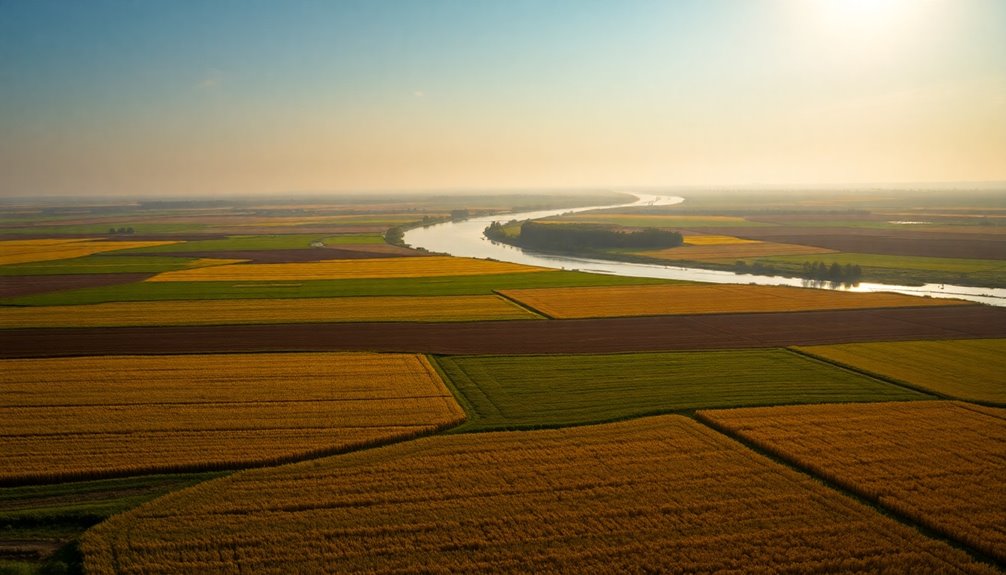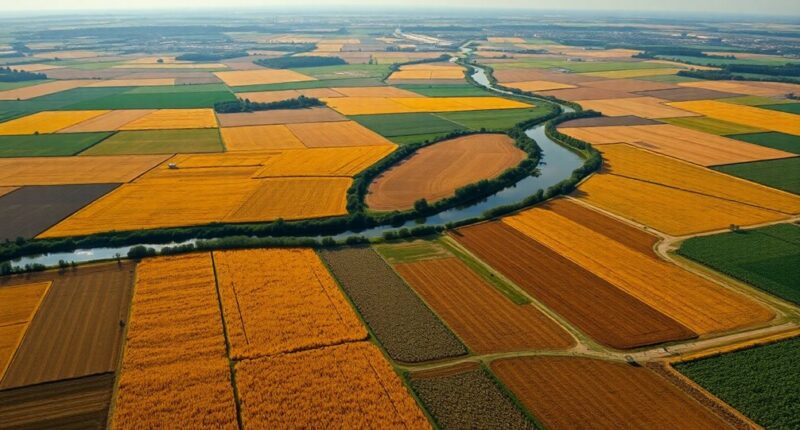Global crop production creates significant environmental ripples. You might not realize that agriculture occupies 50% of habitable land, causing habitat loss and biodiversity decline. It accounts for 69% of fresh water use, impacting both quality and availability. The livestock sector contributes to greenhouse gas emissions, further exacerbating climate change. These factors intertwine with food security and global market stability. If you're curious about sustainable practices and dietary choices that can mitigate these impacts, there's more to explore.
Key Takeaways
- Global crop production significantly contributes to habitat loss and biodiversity reduction due to farmland expansion and ecosystem destruction.
- Agricultural practices, such as excessive water use, degrade water quality and availability, impacting ecosystems and human communities.
- Climate change poses risks to crop yields, with some crops potentially experiencing declines, affecting global food security and market stability.
- Sustainable agriculture practices, like no-till farming and agroforestry, can mitigate environmental impacts and promote ecosystem health.
- Dietary choices, including reduced food waste and plant-based diets, can lessen the environmental strain of global food systems.

As global crops continue to shape our food systems, you mightn't realize the profound environmental ripples they create. Agriculture occupies about 50% of the Earth's habitable land, leading to significant habitat loss and a reduction in biodiversity. This expansion often means converting forests into farmland, which destroys ecosystems and contributes to greenhouse gas emissions. In fact, the livestock sector alone accounts for 18% of these emissions, highlighting the environmental cost of our dietary choices. Camping locations like national parks are often affected by these agricultural practices, as they can experience habitat encroachment.
Water consumption in agriculture is another pressing issue. The sector uses approximately 69% of the world's fresh water, affecting not just availability but also water quality. Excess water use can lead to pollution from pesticides and fertilizers, which disrupts local ecosystems. You mightn't think about it, but the techniques farmers use can result in soil degradation and erosion, further harming our environment. The agricultural sector consumes about 69% of the planet's fresh water, underscoring the urgency for sustainable practices.
Agriculture's water consumption impacts both availability and quality, leading to pollution and soil degradation that harm our ecosystems.
Climate change also plays a critical role in crop yields. It's expected that by 2030, maize yields could decline by 24%, while wheat might see a modest increase of 17%. Rising temperatures and shifting rainfall patterns can exacerbate these challenges, accelerating crop maturity and impacting food security. With interconnected food systems, local changes in yield can ripple through global markets, affecting availability and prices.
However, there's hope through sustainable agriculture practices. By prioritizing biodiversity conservation and improving soil health with methods like no-till farming and cover crops, you can help mitigate these environmental impacts. Sustainable irrigation techniques also promote water efficiency, while reducing chemical use minimizes pollution. Agroforestry adds another layer of benefit, sequestering carbon and providing additional income for farmers.
As you navigate your dietary choices, consider the broader implications. Reducing food waste and shifting toward plant-based diets can lessen the environmental strain and promote a more sustainable future for our global food systems. By making informed choices, you contribute to a healthier planet.
Frequently Asked Questions
How Do Global Crops Affect Local Biodiversity?
Global crops affect local biodiversity significantly. When you convert diverse ecosystems into monoculture fields, you reduce habitat variety, leading to a decline in species richness.
The chemicals used in farming can harm soil health and disrupt vital ecosystem services. Additionally, the reliance on a few crop varieties diminishes genetic diversity, making crops more susceptible to pests and diseases.
This loss of biodiversity ultimately threatens not only local ecosystems but also the sustainability of agricultural practices.
What Role Do Farmers Play in Environmental Ripples?
You mightn't realize it, but your farming choices ripple through the environment like stones tossed into a pond.
As a farmer, you play a crucial role in shaping ecological health. By adopting practices like crop rotation and cover cropping, you enhance soil fertility and reduce erosion.
Your decisions impact water conservation and biodiversity, helping to mitigate pollution and climate change.
Ultimately, your commitment to sustainability can create a healthier planet for future generations.
Are There Any Economic Impacts From These Environmental Changes?
Yes, there are significant economic impacts from environmental changes.
As crop yields fluctuate, you'll see food price volatility affecting your wallet. Regions reliant on specific crops might face economic instability, while others could thrive with increased yields.
Job losses in agriculture due to these changes can hit local economies hard. Adapting through resilient crops and improved practices is essential to mitigate these impacts and ensure economic stability in your community.
How Can Consumers Influence Sustainable Crop Production?
You can influence sustainable crop production by choosing certified organic products and supporting local farmers.
When you buy Fair Trade items, you promote equitable labor practices and better environmental standards.
Reducing food waste through meal planning and utilizing leftovers also helps minimize demand for unsustainable farming.
What Are the Long-Term Consequences of Monoculture Practices?
Monoculture practices can lead to serious long-term consequences for soil health and biodiversity.
You'll notice soil fertility declines, making it dependent on artificial fertilizers. This farming method reduces species diversity, harming ecosystem services like pollination.
Plus, it increases vulnerability to pests and diseases, raising reliance on harmful chemicals.
Ultimately, monoculture threatens sustainability, increasing risks of crop failures and economic losses, while making agricultural systems less resilient to climate change impacts.
Conclusion
In summary, the environmental ripples from global crops reveal complex interconnections that impact ecosystems worldwide. Did you know that agriculture accounts for about 70% of freshwater use globally? This staggering statistic highlights the urgent need for sustainable practices. By acknowledging these dimensions, you can appreciate the delicate balance between food production and environmental health. It's crucial to consider how your choices can help mitigate these effects and promote a more sustainable future for our planet.









